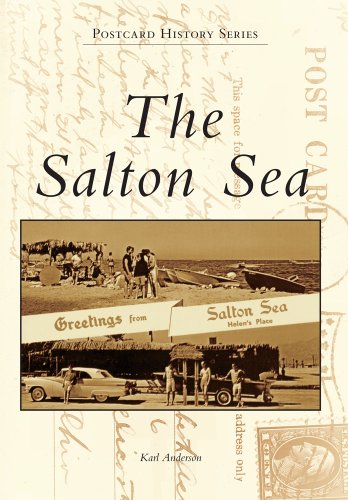-
The Salton Sea
Karl Anderson
Paperback (Arcadia Publishing, June 27, 2011)The Salton Sea was an accident of man created when heavy rainfall caused the Rio Colorado to swell and breach an Imperial Valley dike in 1905. For two years, water flowed into the Salton Sink and ancient Lake Cahuilla. Today, the sea is 227 feet below sea level, covers approximately 376 square miles, and is California's largest lake. During the early 1900s, it became an important bird and waterfowl refuge. When many species of fish were introduced, the Salton Sea also became popular for boating, fishing, hunting, and camping activities. Motels, yacht clubs, and marinas developed around Salton City and North Shore. During recent decades, the sea has become polluted from agricultural runoff, creating a doubtful future for the Salton Sea. However, it remains a sanctuary for anyone who enjoys bird watching, desert landscapes, or beautiful farmlands.
-
Weymouth
William J. Pepe, Elaine A. Pepe
Paperback (Arcadia Publishing, March 16, 2004)Weymouth offers a glimpse into the history of the Bay State's second-oldest town through one of the most nostalgic media of the early twentieth century: postcards. Between 1902 and 1965, almost anyone or anything of significance in Weymouth was captured by local postcard publishers, such as Hunt's News Room. The cards showed nearly every aspect of life in Weymouth, from maritime commerce and railroads to town fairs and harness racing. With images of local churches, elaborate homes of the early twentieth century, trolley cars, sailboats, and Weymouth war heroes, this compilation, created from the authors' collection of more than eight hundred Weymouth postcards, offers something for collectors and residents alike.
-
The Benjamin Franklin Parkway
Harry Kyriakodis
Paperback (Arcadia Publishing, July 7, 2014)The Benjamin Franklin Parkway has sliced through the Logan Square neighborhood of Center City (downtown) Philadelphia since World War I. Named after Philadelphia's favorite son, the mile-long boulevard begins at city hall and heads diagonally towards Logan Circle before reaching the Philadelphia Museum of Art. The postcards and other images in this work show the parkway's development and its role in Philadelphia's civic and cultural life. Despite often serving as a speedway into and out of town, the Ben Franklin Parkway is a triumph in urban planning that has become a treasured part of the City of Brotherly Love.
-
Huntington Beach
Marvin Carlberg, Chris Epting
Paperback (Arcadia Publishing, May 13, 2009)For more than 100 years, Huntington Beach has been a scenic haven for locals and tourists alike. Huntington Beach has also been the subject of many postcards. After all, "Surf City, USA" is a wonderfully picturesque place. Compelling printed images of the famous pier, downtown, the parks, people, agriculture, and businesses became some of the city's most popular souvenirs. Postcards such as these evoke the magic of long-gone summers; wistful, nostalgic glimpses of a classic Southern California beach city--and they are just as lovely today as they were decades ago.
-
Hudson River: From New York City to Albany
Irwin Richman
Paperback (Arcadia Publishing, Sept. 13, 2001)Often characterized as the "American Rhine," the Hudson is a vast tidal river that moves in two directions. The Hudson River Valley, from the Capital Region south to where the river meets the Atlantic Ocean in New York Bay, is one of the most varied and exciting areas of America-a region rich in splendor and beauty, history and grandeur, poverty and decay. It shaped a region.
-
Lake Bluff
Lyndon Jensen, Kathleen O'Hara
Paperback (Arcadia Publishing, June 25, 2008)The shores of Lake Michigan, with towering bluffs and heavily wooded ravines, have attracted many to Lake Bluff during the past two centuries. The Potawatomis were the first to come, using the ravines for their tribal council meetings. The German and Irish came in the 1830s, drawn by the cheap land prices. The 1870s brought the Methodists, who, seeing the beauty of the lake and the ravines, purchased 200 acres and formed the Lake Bluff Camp Meeting Association. The summer chautauqua brought thousands of visitors every year to its quaint cottages and hotels. It was in Lake Bluff where Frances Willard, president of the Women's Christian Temperance Union, brought together other temperance leaders to form the national Prohibition party, which led to the ill-fated 18th Amendment. In the 20th century, Lake Bluff has retained its charming cottages and tree-lined village streets. It remains today a picturesque and historic northern suburb of Chicago, nestled along the shores of Lake Michigan.
-
Gettysburg Postcards: Vintage Postcard Views of America’s Greatest Battlefield
James D. Ristine
Paperback (Arcadia Publishing, Nov. 15, 1999)From the 1890s through the 1920s, the postcard was an extraordinarily popular means of communication, and many of the postcards produced during this "golden age" can today be considered works of art. Postcard photographers traveled the length and breadth of the nation snapping photographs of busy street scenes, documenting local landmarks, and assembling crowds of local children only too happy to pose for a picture. These images, printed as postcards and sold in general stores across the country, survive as telling reminders of an important era in America's history. This fascinating new history of Gettysburg, Pennsylvania, and its famous battlefield, showcases more than two hundred of the best vintage postcards available.